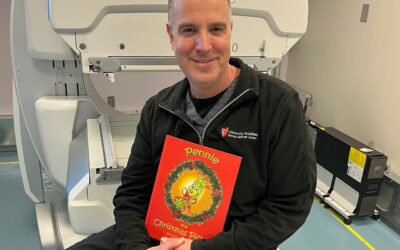By K. Richard Douglas
Since just after the Civil War, the University of Pittsburgh Medical Center (UPMC) Shadyside Hospital has served the people of the tristate area and the residents of Pittsburgh, where it is located. The 520-bed hospital includes nearly 1,000 physicians and has earned Magnet status from the American Nurses Credentialing Center. UPMC is closely affiliated with the University of Pittsburgh.
At UPMC Shadyside, the imaging and equipment maintenance, management and repairs are handled by BioTronics. BioTronics is UPMC’s clinical engineering department. It is fully owned by UPMC but does some third-party work as well.
A member of leadership, within the HTM ranks at UPMC/BioTronics commends their imaging manager for being so patient-focused.
“Bob is a great example of someone rising through the ranks to reach the highest levels of technology and customer support,” says Joseph “Joe” A. Haduch, MBA, MS, senior director of clinical engineering at UPMC/BioTronics.
Haduck is referring to Robert “Bob” Hedderman, radiology enterprise engineer for BioTronics at the UPMC Shadyside.
“Bob is a graduate of Penn State’s Biomedical Equipment Program and also served in the Naval Reserve,” Haduch adds.
Haduck says that Hedderman has a strong patient focus and that he transitioned to CT, and then PET/CT, and is one of the foremost in-house authorities on PET technology.
“In addition, Bob manages our imaging department at Shadyside Hospital, but what separates Bob from everyone else is his unwavering dedication to his craft and the patients he serves. Bob has over 25 years in clinical engineering experience but his most valued skill set is how he supports his customers, his colleagues and the clinicians throughout UPMC,” Haduck says.
“His commitment puts the needs of the patients ahead of his own personal interests. Bob consistently works weekends, after hours, often without prior scheduling, to make sure our patients expectations and needs are met,” Haduck adds.
Navy Benefits
Hedderman first found an interest in HTM because of the Navy.
“I became interested in the biomedical field when I visited the Navy recruiter back in 1986,” he says.
“He informed me of a new program the Navy Reserves were offering with a six-year enlistment that would cover 100 percent of the tuition for two-year medical programs at Penn State. Since I was already interested in electronics, I decided on biomedical equipment technology,” Hedderman remembers.
He ended up attending a branch campus of Penn State and received an associate degree in biomedical engineering technology.
As Haduck pointed out, Hedderman made the jump from biomed to imaging with additional training.
“The hospital that I was working for at the time was expanding its in-house imaging service program to nuclear medicine. Since I showed interest, my employer sent me to RSTI for the nuclear medicine introduction course, before I attended manufacturer training,” Hedderman says.
“I also continued into radiology with RSTI and Ditech levels 1, 2 and 3 before attending several manufacturer training courses. Since then, I was hired by my current employer UPMC where I serviced the radiology equipment for five years before I was presented [with] the opportunity to service CT and PET,” Hedderman adds.
Since entering the field, Hedderman has worked as a biomedical equipment technician, biomedical equipment specialist, radiology equipment technician, radiology equipment specialist and finally as a radiology enterprise engineer.
Hedderman remembers the transition to imaging as a little intimidating, at first.
“The biggest challenge for me as an imaging professional was stepping out of my comfort zone as a biomed and accepting the opportunity for training in nuclear medicine. I was a biomed only a few years and was working with the OEM engineer on a nuclear imaging problem and remember thinking how knowledgeable the FSE was and doubted if I could handle servicing imaging systems. Looking back, accepting that challenge was only a stepping stone and turned out to be the best decision of my career,” he says.
 Helping Fellow Troops
Helping Fellow Troops
Hedderman recalls one prior challenge from when he was part of Desert Storm. Fleet Hospital 6, which had been prepositioned in Japan, was activated in December of 1990. It was assembled near Alwardi, Bahrain. The hospital remained active until the spring of 1991.
“As a reservist, I was activated for the first Gulf War and served as corpsman/biomed for Fleet Hospital 6 in Bahrain. Fleet Hospital 6 was a 500-bed Navy field hospital, that was climate controlled with heating and air conditioning, included several operation rooms, an X-ray room, a lab and a dental department,” Hedderman says.
“Our biomed department consisted of eight to 10 technicians and our primary responsibilities consisted of unpacking and testing the new equipment. Since the war ended so quickly, and we only had a few non-combat related injuries, most the equipment wasn’t used and the hospital was only in service a few months,” he adds.
When not on the job, Hedderman enjoys hunting, fishing and the outdoors. He has been happily married for 26 years to his wife, Pam, and has a 21-year-old son and an 18-year-old daughter.
“Since both of my kids are in college I no longer coach my son’s hockey team or spend weekends watching my daughter play softball. I am able to spend more time doing outdoor activities, such as kayaking with my wife or archery hunting,” he says.
“This may sound crazy to some people, but I’m sure some can relate. Besides spending time with my family, there is nothing more enjoyable to me than sitting in a tree stand on an autumn morning in the middle of nowhere archery hunting,” he adds.
It is the peacefulness of a fall tree stand that provides a break from the important work of this imaging service specialist.
Rising Star Nomination








